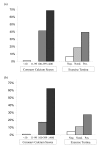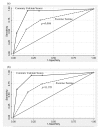Measurement of coronary calcium scores or exercise testing as initial screening tool in asymptomatic subjects with ST-T changes on the resting ECG: an evaluation study
- PMID: 17629903
- PMCID: PMC1959245
- DOI: 10.1186/1471-2261-7-19
Measurement of coronary calcium scores or exercise testing as initial screening tool in asymptomatic subjects with ST-T changes on the resting ECG: an evaluation study
Abstract
Background: Asymptomatic subjects at intermediate coronary risk may need diagnostic testing for risk stratification. Both measurement of coronary calcium scores and exercise testing are well established tests for this purpose. However, it is not clear which test should be preferred as initial diagnostic test. We evaluated the prevalence of documented coronary artery disease (CAD) according to calcium scores and exercise test results.
Methods: Asymptomatic subjects with ST-T changes on a rest ECG were selected from the population based PREVEND cohort study and underwent measurement of calcium scores by electron beam tomography and exercise testing. With calcium scores > or =10 or a positive exercise test, myocardial perfusion imaging (MPS) or coronary angiography (CAG) was recommended. The primary endpoint was documented obstructive CAD (>/=50% stenosis).
Results: Of 153 subjects included, 149 subjects completed the study protocol. Calcium scores > or =400, 100-399, 10-99 and <10 were found in 16, 29, 18 and 86 subjects and the primary endpoint was present in 11 (69%), 12 (41%), 0 (0%) and 1 (1%) subjects, respectively. A positive, nondiagnostic and negative exercise test was present in 33, 27 and 89 subjects and the primary endpoint was present in 13 (39%), 5 (19%) and 6 (7%) subjects, respectively. Receiver operator characteristics analysis showed that the area under the curve, as measure of diagnostic yield, of 0.91 (95% CI 0.84-0.97) for calcium scores was superior to 0.74 (95% CI 0.64-0.83) for exercise testing (p = 0.004).
Conclusion: Measurement of coronary calcium scores is an appropriate initial non-invasive test in asymptomatic subjects at increased coronary risk.
Figures



References
-
- Smith SC, Jr., Greenland P, Grundy SM. AHA Conference Proceedings. Prevention conference V: Beyond secondary prevention: Identifying the high-risk patient for primary prevention: executive summary. American Heart Association. Circulation. 2000;101:111–116. - PubMed
-
- Hendel RC, Patel MR, Kramer CM, Poon M, Hendel RC, Carr JC, Gerstad NA, Gillam LD, Hodgson JM, Kim RJ, Kramer CM, Lesser JR, Martin ET, Messer JV, Redberg RF, Rubin GD, Rumsfeld JS, Taylor AJ, Weigold WG, Woodard PK, Brindis RG, Hendel RC, Douglas PS, Peterson ED, Wolk MJ, Allen JM, Patel MR. ACCF/ACR/SCCT/SCMR/ASNC/NASCI/SCAI/SIR 2006 appropriateness criteria for cardiac computed tomography and cardiac magnetic resonance imaging: a report of the American College of Cardiology Foundation Quality Strategic Directions Committee Appropriateness Criteria Working Group, American College of Radiology, Society of Cardiovascular Computed Tomography, Society for Cardiovascular Magnetic Resonance, American Society of Nuclear Cardiology, North American Society for Cardiac Imaging, Society for Cardiovascular Angiography and Interventions, and Society of Interventional Radiology. J Am Coll Cardiol. 2006;48:1475–1497. doi: 10.1016/j.jacc.2006.07.003. - DOI - PubMed
-
- Greenland P, Bonow RO, Brundage BH, Budoff MJ, Eisenberg MJ, Grundy SM, Lauer MS, Post WS, Raggi P, Redberg RF, Rodgers GP, Shaw LJ, Taylor AJ, Weintraub WS. ACCF/AHA 2007 clinical expert consensus document on coronary artery calcium scoring by computed tomography in global cardiovascular risk assessment and in evaluation of patients with chest pain: a report of the American College of Cardiology Foundation Clinical Expert Consensus Task Force (ACCF/AHA Writing Committee to Update the 2000 Expert Consensus Document on Electron Beam Computed Tomography) developed in collaboration with the Society of Atherosclerosis Imaging and Prevention and the Society of Cardiovascular Computed Tomography. J Am Coll Cardiol. 2007;49:378–402. doi: 10.1016/j.jacc.2006.10.001. - DOI - PubMed
-
- Budoff MJ, Achenbach S, Blumenthal RS, Carr JJ, Goldin JG, Greenland P, Guerci AD, Lima JA, Rader DJ, Rubin GD, Shaw LJ, Wiegers SE. Assessment of coronary artery disease by cardiac computed tomography: a scientific statement from the American Heart Association Committee on Cardiovascular Imaging and Intervention, Council on Cardiovascular Radiology and Intervention, and Committee on Cardiac Imaging, Council on Clinical Cardiology. Circulation. 2006;114:1761–1791. doi: 10.1161/CIRCULATIONAHA.106.178458. - DOI - PubMed
Publication types
MeSH terms
LinkOut - more resources
Full Text Sources
Medical
Molecular Biology Databases
Miscellaneous

